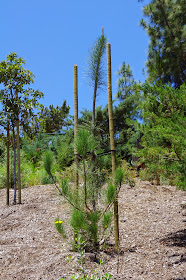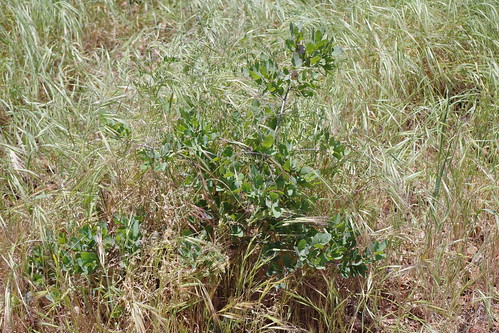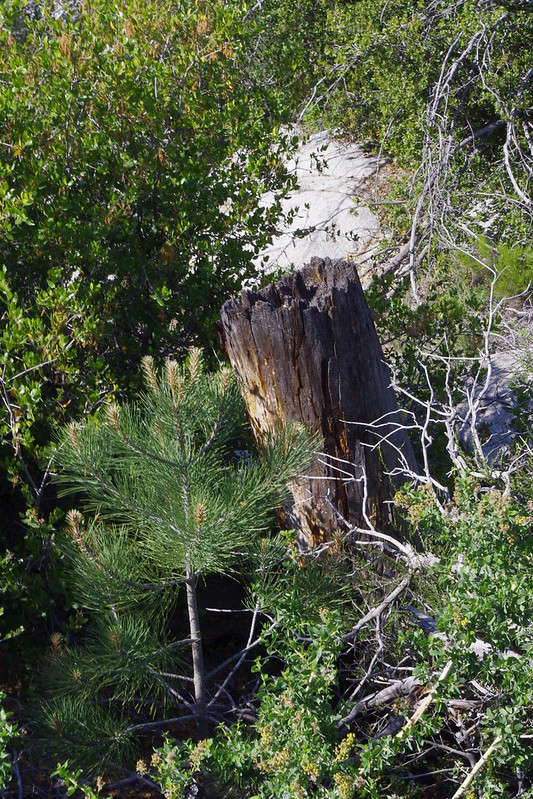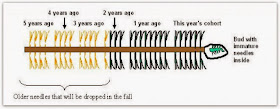The reality is Chaparral plants do have other value and worth in the tender young tree structural support department. Unfortunately for these plants, the ignorance of exactly what benefits they do provide go mostly unnoticed or if known buried in the prevailing popular conventional literature and University textbooks, in favour of failed management policies mandated as successful which favour big business interests striving for monoculture forest products. As you can see in this photo at left, this is a Coulter Pine Sapling emerging from the Chaparral in a former burn from the 1990s. This particular tree is along a now extinct creek bed which was deliberately made extinct by diverting an ancient stream bed higher up in elevation to prevent a bridge being constructed over the creek on Hwy State Route 74 in favour of a cheap small culvert. The evidence and constructed berm are still up there, but mostly buried and covered over by vegetation. This tree is the resulting germination after that arson set fire and well away from the Hwy 74. There are no trails here. I only was able to find this shot by means of bushwhacking with friends. But notice the Staking ability of the chaparral to keep the delicate tree upright and strong and all the while providing water and nutrients even during these drought times. Of course this was taken in Spring of 2013, so maybe circumstances have changed as they have elsewhere. Nevertheless, this is what urban landscapers have to do artificially when creating a landscape scenario. Many trees just won't do well without staking or propping up with large poles. Below I have personal examples of my own and those I saw at some of the newer landscape features at the San Diego Safari Park near Escondido, California.
This is an Engelmann Oak (Quercus engelmannii) which I purchased in the middle of April 2013 from Las Pilitas Native Plant Nursery north of Escondido. This photo was actually taken at the middle of June 2013 just the day before I left to fly back to Sweden. When I originally purchased the tree, it was only about 10" high. You can see the newer top growth which grew from the previous year's bud formation after I planted it in it's new permanent location in my Mum's front yard. So it grew maybe another 10 or so inches while I was there. One of the other benefits of course was a healthy blend of mycorrhizal inoculent at the time of planting. Never ever plant a native without doing that to ensure it's lifetime health and survival. I do not like getting 5 gallon or larger trees. In my experience these one gallon will eventually out perform the ready made tall landscape trees demanded by most homeowners and/or commercial business enterprises. Unfortunately people are impatient and want instant landscape, but the next photo here below which I took at the end of this years trip the 1st of July 2014 reveals a year old planting which is presently over a meter in height and in desperate need of artificial staking as a result. Even with the many longer side branches which will eventually provide a measure of stability, this tree still needs staking. The staking itself was done this year when I first arrived. I never did stake it in the beginning, even after the 10 inch growth spurt. The continual growth was incredible after replicating a deep soaking rain with the garden hose for a few days when I first arrived. The abnormal lack of rain this winter season in San Diego and all of California actually necessitates artificially deep soaking during winter months to replicate deep soil moisture which will be utilized throughout the rest of the year if you plan it correctly.
 |
| Engelmann Oak (Quercus engelmannii) |
It should be noted that when I left the end of the first week of July 2014, the Oak was still growing, but more slowly, which is a good thing because I wanted it to harden off and toughen up. Who knows how big it will get next season. Still, one mete in a year wasn't a bad deal, even for the landscape impatient folks. I believe this is all the staking I will do. Trees need an element of wind swaying them back and forth to toughen up it's woody structure. If over done, then the tree again never develops properly on it's own. The situation turns into a type of tree bondage arrangement where the tree becomes dependent on a type of welfare entitlement and that is an undesirable goal for your landscape. For me, this is a sort of an "enabling" behavior, much like when you mix generous amounts of unnecessary soil amendment into the planting hole or establish a permanent drip system immediately around the trunk of the tree and it stays there for years. The tree simply will not mature the way it's supposed to. The goal here is to replicate the wild. The drip line in the above photo is no longer functional near the tree and none of the drip emitters provide anything to the oak. This was a previous line to other roses which are mostly gone except for the one or two in the background behind the Oak in the picture. Below here is a gallery of trees I photographed at the San Diego Safari Park near Escondido. They are indeed in need of staking, many of them Torrey Pines which are chaparral dependent.
 |
| Tree staked Torrey Pine @ San Diego Safari Park |
Torrey Pines are long and leggy when young, especially in the urban landscape where water is plentiful and competition is usually nonexistent. They really do need chaparral in their youth. The area in which these beautiful pines growth actually receives very little rainfall by comparison to most pine habitats in the mountains of California. So the Torreys are very dependent on deeper rooted chaparral for their water requirements during those dry periods of the year. Of course the very mild climate along the coast coupled with the low clouds and fog of May-Gray & June-Gloom help a lot as well. Still, these tough trees excel in other ways and under other unique circumstances inland, but once again the chaparral are the main component necessary for survival as I have proven previously.
Below is an older grove of Torrey Pines at the San Diego Safari Park. Back when it was the San Diego Wild Animal Park there was a trail system which past under these trees. The area is a mix of chaparral in and around the grove of Torreys. Laurel Sumac and Lemonade Berry are the predominant shrubs mixed within this area. In a future post maybe I'll write about the Torrey Pine potential as a wood product tree. Most of the literature speaks of it as an inferior source for lumber, but they generally make such judgement calls based on it's growth along the coastal areas where it is still wild, but mostly in rounded and twisted picturesque forms. That would be a given, but when grown in the interior, they grow straight and tall with very few limbs on the lower truck.
The Torrey Pine below is one where I experimented back in the late 1970s with the understanding that there is great potential of utilizing a nurse tree. In this case a Torrey Pine nursed along by a Laurel Sumac Chaparral shrub. At the time of this picture in 2011, this particular tree was between 25-30 in height. Landscape conditions would have more than doubled that trees size, but the experiment was to see what could happen in the wild and under harsh hotter and drier condition than where they are restricted as natives along the much cooler coastal areas around Del Mar. As far as I'm concerned the experiment was a success as I viewed it over the decades, which aloud me to replicate this in several places in and around Anza Valley where there are small woodlands of pines in areas the Forestry officials said would never become a success. Fortunately they were wrong.
Unfortunately however, in hind sight, it apparently was a mistake to have written about and photographed where those Torrey Pine trees were located down in El Cajon on Rattlesnake Mountain. The biologist behind the Conservation Area project which oversees the protection of such endangered species in the coastal chaparral scrub there such as the California Knatcatcher songbird as much as hinted that he was alerted to the trees after I had asked why they were cut down with chainsaw. Evidently some reader complained. Frankly it really doesn't matter as I gained so much anyway from the experience, but it was still a cowardly thing to do. He was vague as to having anything to do with what the people up there in the Sky Ranch housing development did in chain sawing them down. But what's done is done. At least it's been documented and there for teaching purposes only.
Interestingly in the early years, that Torrey in the above photo and the others out of the picture to the right and left of this tree were almost completely smothered by the luxuriant Laurel Sumac foliage, but eventually they all of them exploded through the heavy shrub canopy. Now taking a different direction, take a close look at what I call a pine tree health gauge or ruler from the illustration below. Each whorl of a pine tree's branch reveals where next years buds form can as a general rule in the wild be considered one years worth of growth. Of course in the landscape there could be several growth whorls within a year and depending on the species, like Pinus halepensis which almost can have continuous growth and whorls given the ideal growing circumstances. But for the most part, California native pines have one whorl per year, unless it goes through an exceptionally wet El Nino period. I've had all my pines in Anza as well as this one above having the ability of keeping five or six years worth of needles on the growth whorls still intact and present on the tree even during dry years. In each case they were all connected to chaparral plants within the ecosystem. That's usually a sign of good health. It's when a pine gets down to one or only two years of whorls of needles, that a landscaper or homeowner should start to worry that the tree is drought stressing and in need of moisture. You seriously will need to get moisture to those trees quickly and manually if necessary. If chaparral are present in and around the trees, this is generally unnecessary in my experience.
The photograph below is of a location around the interchange of Freeways 15 & 52 near Miramar Naval Air Station where the 2003 Cedar fire blew through. Afterwards a bold attempt was made to use natives such as Torrey Pines and also California Sycamores on the banks above the shoulders. There was a massive amount of irrigation infrastructure installed everywhere to support these trees. In the beginning they were young and beautiful, but they were placed out on open sterile ground like most conventional landscapes with no real artistic imagination or placement other than rows of trees and planted with the same techniques and traditional understanding of plant establishment the US Forest Service uses when they plant pines on ground prepared by stripping it of all chaparral and then lightly tilling it. I understand that CalTran's Officials probably considers the chaparral a fire facilitator [especially after the Cedar Fire 2003], but so is any other landscape vegetation whether native or exotic. The fact is these trees would be far larger and have a much healthier history of dense foliage had they first planted and established chaparral shrubs in the beginning first couple of years, then planted those Torrey Pines thereafter. In the beginning they had staking because they were already several year old large container plants, but that doesn't help these plants now. Seriously, remember what I said about one gallon plants. Given the present drought crisis, I don't know if any of this can be salvaged. I don't think they have the water or motivational drive to even try.
 |
| Image Google Earth - Interstate 15 near Freeway 52 |
~~~~~~~~~~~~~~~~~~~~~~~~~~~~~~~~~~
Oak Woodlands need Chaparral for Successful Advancement
 |
| Hwy 79 @ Schoolhouse Rd |
Incredibly, I stumbled across a website from the organization called the "Pleasant Valley Conservancy" which champions the care and maintenance of Oak Savanna woodlands. This group is based in Wisconsin and it's website reveals some incredible marketing and propaganda strategies which explains how & why human attitudes about the wild can be warped even from an early age over decades of time. The first quote below is what I would call a propaganda quote which champions the justification for fire. Not that fire isn't natural and cannot be used as a tool, but in the last century it has been over promoted and justified with just such misinformation as contained within the quote below:
"One of the principal reasons for clearing the undergrowth from around these open-grown oaks is to encourage acorn production. Acorns are the most important wildlife food and acorn production is best in healthy oaks that are able to "spread their wings".In all my years I have never found oaks more productive in Acorn production because of so-called removal of competition from other plants. The idea here is that grasses and chaparral prevent the oak tree from having productive acorn seasons. No doubt further propaganda would have it that the Native Americans knew this. Seriously, I have seen old growth forests and heavy old growth chaparral plant communities intermingled with large massive oaks in which were exceptionally productive Acorn season year after year. Trust me, the Natives would have also seen what I have experienced as well, but it doesn't make for as romantic a story line to those with a vested interest in some money making venture. I know because I collected acorns in the past and processed them for meal production. Large Oaks within heavy Chaparral plant cover were the heaviest producers when I went out into the bush. Then there was this subheading on that first page calling attention to people's perception of what they considered a healthy forest is out in Nature. This had more to do with marketing an opinion and biased ideology more than anything else. They polled the people as to what they thought looks more aesthetically pleasing:
Aesthetics of the Oak Savanna Landscape
"Surveys of attitudes and perceptions have shown that the oak savanna landscape rates highly in the public mind. Open forests with large, relatively old trees are considered very attractive. Other pleasing factors of the oak savanna include the high plant diversity, the presence of wild flowers, the large openings surrounded by trees, and the extensive vistas and overlooks. These are characteristic of parks, and the park-like setting of oak savannas is appealing, just as it was to early travelers through the Midwest."
http://pleasantvalleyconservancy.org/savannas.html
~~~~~~~~~~~~~~~~~~~~~~~~~~~~~~~~~~This is the exact marketing put out there by the US Forest Service. This is the mirror image of the mandated purpose up in the San Jacinto Mountains by the Palms to Pines highway beautification project and maintenance program. Show people park-like conditions which appear to be the most aesthetically pleasing to the average Joe/Jane Q-Public driving thru the area in their car and they'll imagine you are doing your job properly. Now I do like Oak Savannas and there is no doubt a historical presence throughout California's central valley & surrounding lower foothills for them, especially considering at one time there was an historical presence of more than 500,000 Elk alone which no doubt maintained such Oak Savanna areas. But much of the mountainous regions on the west side of the central valley to the coast of California has been ruined by overgrazing and removal of large tracts of chaparral where majestic oaks and Foothill pine have been left. Eventually these older trees will die and those Oak Savannas will be gone. What will be leftover is nothing but non-native grasslands and other exotic weeds. I saw it this past June 2014 when my wife and I traveled from Buttonwillow California over highway 58 to Santa Margarita on our way to Monterey up Hwy 101. The grazing that has been allowed on numerous steep slopes of mountainsides for miles and miles has cattle which have mowed the grasses to the ground where nothing now but bare soil exists. There are some pockets of large Oaks spread out here and there, but also many dead ones. There is zero presence of regeneration as would be evidenced by the existence of various younger to middle aged trees even over the last few decades. There's nothing but old oak trees and dead remnants. Even Foothill Pines are dying everywhere and lack of anything new, with the exception of maybe some roadside pine germination because of concentrated road runoff. Oaks and Pines in California need chaparral nurse feeding, hydrating and staking. Chaparral historically provided everything they needed. If humans don't get their act together with regards proper custodianship of Earth, then like climate change, all plant ecosystems may also end up at a point of no return.
~~~~~~~~~~~~~~~~~~~~~~~~~~~~~~~~~~~
Ideas and Plans for using Chaparral in the Landscape
~~~~~~~~~~~~~~~~~~~~~~~~~~~~~~~~~~
Additional Tree Staking Resources:
Girdling Roots -- A Problem of Shade Trees, Ohio State University Extension
http://ohioline.osu.edu/hyg-fact/1000/1139.html
Planting Guidelines: Container Trees & Shrubs, University of Arizona Cooperative Extension
http://extension.arizona.edu/sites/extension.arizona.edu/files/pubs/az1022.pdf
The Myth of Staking: "Newly planted trees should be staked firmly and securely",
Linda Chalker-Scott, Ph.D., Extension Horticulturist and Associate Professor, Puyallup, Research and Extension Center, Washington State University
http://puyallup.wsu.edu/~linda%20chalker-scott/horticultural%20myths_files/Myths/Staking.pdf







%2B-%2BCopy.jpg)


No comments:
Post a Comment
Thanks for visiting and stopping by with your comments!
I will try to respond to each comment within a few days, though sometimes I take longer if I'm too busy which appears to be increasing.